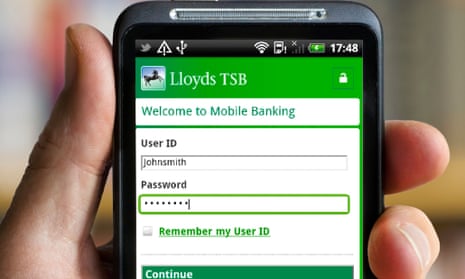The use of bank branches fell by 6% last year as customers channelled more transactions over phone networks and the internet, according to a report published on Sunday that predicts the use of smartphones and tablets will usurp branches this year.
It insists, however, that banks are not giving up on bricks and mortar altogether despite a wave of closures and job cuts in recent years.
The British Bankers’ Association (BBA) and the consultants EY point to a new wave of digital technology that banks are preparing to adopt. Among the ideas is one of Halifax to create a wristband that can check the wearer’s identity using their heartbeat. Royal Bank of Scotland has already introduced some fingerprint verification.
The report is published as banks cut jobs and close branches. The number of branches in the UK fell from 13,349 20 years ago to just under 9,702 in 2013. Lloyds is closing 200 branches and cutting 9,000 jobs as it adopts digital technologies. HSBC announced last week that it was to cut 25,000 jobs worldwide, including 8,000 in the UK, in part because of the introduction of new technology.
The BBA also published research by the IT company CACI predicting that customers will check their current accounts on mobile devices about 895m times in 2015, more than the 705m contacts made through branches. Some new banks, such as Atom, have applied for licences to be digital-only banks.
Digital technology is also having an impact on call centres, which experienced a 43% decline in customers between 2008 and 2013. One bank reported a 16% decline in call-centre traffic in the two years to March 2015. Another saw a fall of 12% over the same period.
In 2009, customers called banks nearly 50m times to transfer money betweentheir accounts. By the end of 2013, the figure had fallen to just over 16m.
The BBA report said: “While most banks have been reducing the size of their high street presence since the 1980s, the death of the bank branch has been much overstated. More than a quarter of the UK’s bank branches have been refurbished in the past three years, clearly demonstrating the commitment to bricks and mortar.”
RBS, which is 79% owned by the taxpayer, will spend £420m refurbishing 420 branches this year, it added.
While the report provides figures on the declining use of branches, it also points to a 10% year-on-year increase in internet banking and the 1.3m text messages sent to customers each day to alert them to things such as a potential breach of their overdraft limit.
Anthony Browne, the BBA’s chief executive, said: “Our report shows that there is much to look forward to. Biometric security features will allow us to get hold of our money faster and without going through the rigmarole of passwords and pin codes.”

Comments (…)
Sign in or create your Guardian account to join the discussion